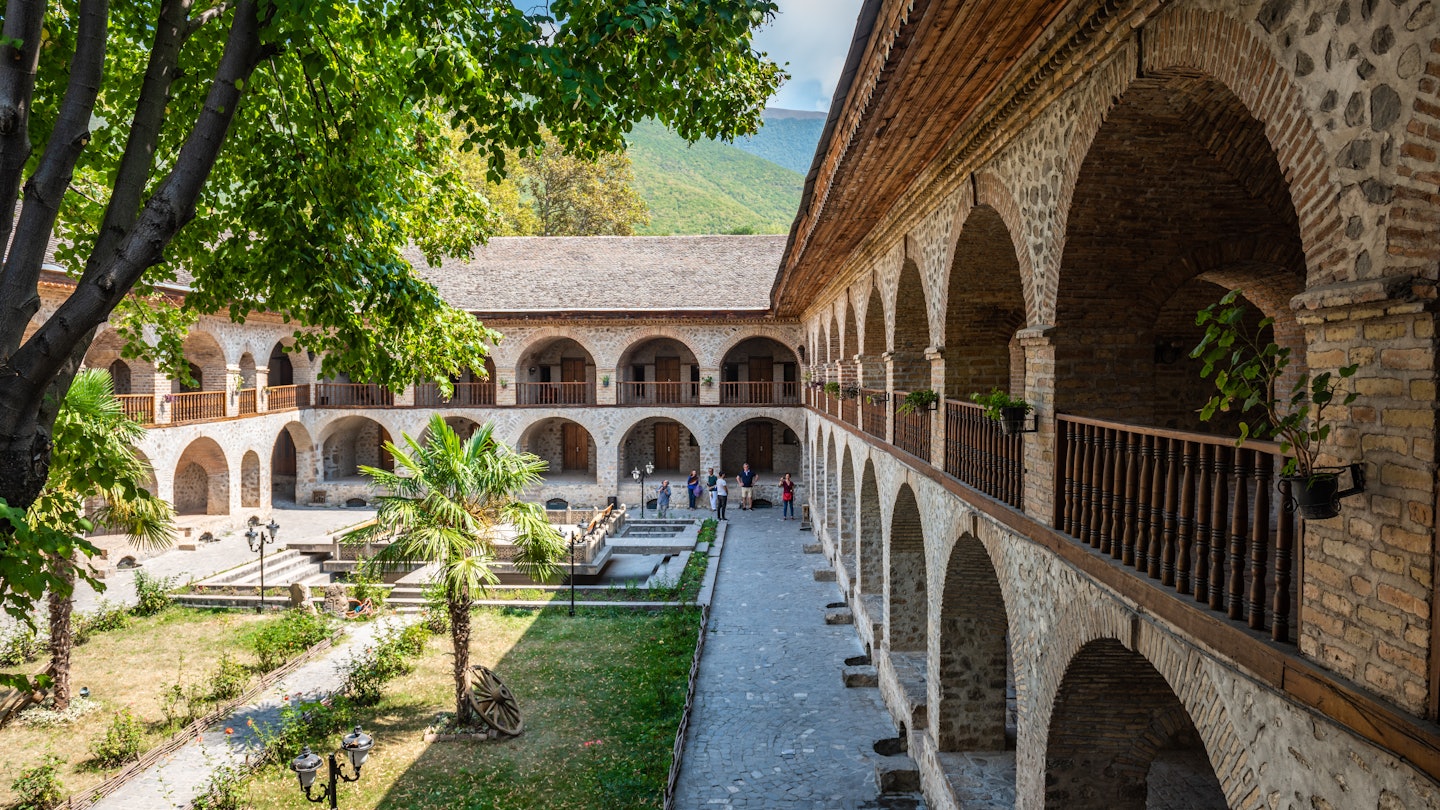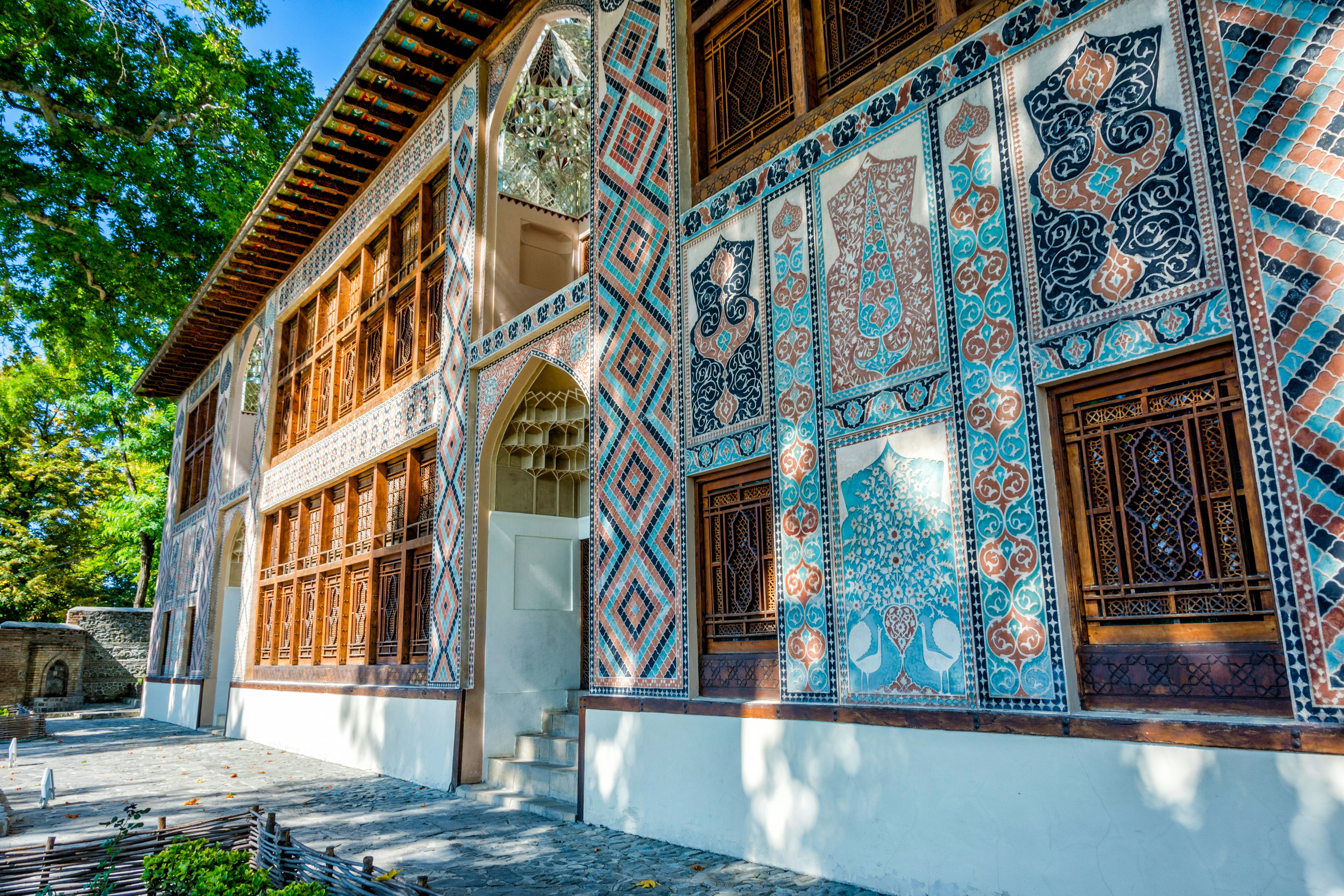
The 30 best countries, cities and regions to visit in 2025
Apr 23, 2025 • 9 min read

This week-long Azerbaijan itinerary takes in ancient culture, warm hospitality and stunning natural landscapes. Vastram/Shutterstock
The largest and most populous country in the South Caucasus has long been described with the "land of contrasts" cliché, and in this case, there is some justification. Neither entirely European nor entirely Asian, Azerbaijan is a nexus of ancient historical empires, but also a “new” nation that has undergone an extraordinary transformation from war-ravaged post-Soviet state in the 1990s to oil-enriched host of Formula 1 and Europa League football today.
In the cosmopolitan capital, Baku, a UNESCO-listed ancient core is encircled by dazzling 21st-century architecture, set on a balmy bay of the Caspian Sea. In the surrounding semi-desert, you'll find curious mud volcanoes and an incredible gallery of petroglyphs.
On this week-long Azerbaijan itinerary, you'll spend a couple of rewarding days in the capital, and also see the roads less traveled. With an extra few days, you can also head north to Shahdag National Park for incredible hiking experiences in the soaring Great Caucasus Mountains. Here's how to see the best of Azerbaijan.
Lowland Azerbaijan is especially lovely in spring, from April to June, as showery days interspersed with clear skies enliven bright-green, flower-dappled fields. Summer can be oppressively hot and humid in low-lying areas but late July is the best hiking season in higher mountain regions.
October is very pleasant in Baku, though much of the rural countryside is parched and brown after the summer. Winters are relatively mild around the Caspian shores, but you'll need a warm coat in Baku and inland, so pack extra sweaters for excursions away from the coast. January to February is the main ski season, a frosty but beautiful time of year in Xınalıq or Lahıc.
Azerbaijan's main airport is Heydar Aliyev International Airport, located a 30-minute drive from the Old City of Baku. A bus runs from outside Terminal 1 to Baku's 28 May station every half an hour. From here, you can take the metro to reach most areas of the city.

Traveling by car is the fastest way of moving around Azerbaijan, especially outside of the capital. You can rent a car to drive yourself, or arrange a car with a driver, and stop wherever you like. The low price of petrol also makes taxis affordable, allowing you to cover long distances at a low cost.
Buses also run to every corner of the country, although schedules are often elusive and booking tickets in advance is not possible. Coaches connect Baku to the major centres, while smaller minibuses run between secondary cities.
Schedules of trains connecting cities in Azerbaijan are available on the Azerbaijan Railways website. In the past, trains also took visitors to Tbilisi and Moscow, but with the land borders currently closed, these routes are not an option for now.
Unlike in some other majority-Muslim countries, women are not required to wear headscarves (except in mosques and churches), and there is no requirement to keep elbows and ankles out of sight. Baku fashion allows for some fairly daring outfits and dramatic makeup, but in the provinces, showing too much skin would be insensitive to local social mores.
This applies to men as well as women. Wearing knee-length shorts is accepted in central Baku and some tourist spots, but elsewhere it is the equivalent of walking around in one's underwear and is best avoided. If you're invited to a family event, it's wise to dress more smartly than you might normally do for a similar occasion at home.

How to spend the day: First, you'll want to explore the labyrinthine streets of Baku’s UNESCO-listed Old City. Enter the Palace of the Shirvanshahs and the Maiden’s Tower to learn about the medieval roots of Azerbaijan’s capital, then continue through convivial Fountains Square and along Nizami St, a large pedestrian and shopping street in downtown Baku.
Next, head for the Bulvar, Baku's waterfront promenade. From National Flag Square, you’ll quickly reach the Baku Eye Ferris wheel, followed by the flower-like Caspian Waterfront Mall and the rolled-carpet-shaped Azerbaijan Carpet Museum.
After learning about Azerbaijan's centuries-old rug-making tradition, stroll through Mini-Venice, where you'll have the opportunity to float in real Venetian gondolas on artificial canals. The State Puppet Theatre, housed in an elegant 1910 oil-boom building designed by Józef Płoszko, sits steps away from a singing statue of composer Muslim Magomayev.
Stop for tea under the concrete sails of the Soviet-era Mirvari Cafe, then check out the garden where 200-year-old baobab trees have been planted. The neoclassical Museum Center (formerly the Lenin Museum) will appear on your left – step inside to check out temporary art exhibitions, as well as the permanent Museum of Musical Culture and Museum of Azerbaijani Independence.
Next, make a stop at the Zaha Hadid-designed Heydar Aliyev Center, followed by any other Baku museums or art galleries that take your fancy. End your day taking the funicular up to Highland Park for sweeping views over the city and the city's iconic Flame Towers, lit by the setting sun.

Go from Baku to Lahij: The drive from Baku to Lahij takes around three hours (172 km/106 miles).
How to spend the day: Known throughout Azerbaijan for its coppersmiths, the mountainous town of Lahij (Lahıc) is located on the high fringes of Ismailly province. It is home to a small community of craftspeople whose workshops face a cobbled street, Hüseynov Küç, that cuts through the village's picturesque heart. As well as craft shopping, you can go hiking in the surrounding mountains and visit the local History Museum and the early 19th-century Zavaro Mosque.
Continue deeper into the sleepy Ismailly region, which features a high density of Ladas, stray dogs and barber shops. Stop in the village of Ivanovka, where the descendants of Russians who clashed with the Orthodox Church run a collective farm producing Ivanovka’s famed honey.
Next, stop at the Chabiant winery to tour the vineyard-covered hills of this appealing region. This isolated winery near Hacıhətəmli village has kept the Caucasian winemaking tradition alive for decades, despite Mikhail Gorbachev’s anti-alcohol campaign in the 1980s, which led to over 80% of Azerbaijan’s vines being destroyed.

Go from Lahij to Sheki: It's a three-hour drive from Lahij to Sheki (156km/97 miles).
How to spend the day: Plan a day to explore lovely Sheki, Azerbaijan’s most charming town, sitting comfortably amid forested slopes in the mountainous northwest, on the long road that connects Baku to the Georgian border. Strategically positioned in the foothills of the Greater Caucasus mountains on the banks of the Gurjana River, the city (formerly known as Nukha) flourished as an important trading center in the Middle Ages, linking to both Tbilisi in Georgia and Derbent in Dagestan.
In the 19th century, Sheki was absorbed into the Russian Empire, and industrialization transformed the town into an important silk-weaving hub. Despite changing times, Sheki has retained some of its historic character, offering visitors a window into its Silk Road past in the form of brick minarets, historic caravanserais and the impressive Palace of the Sheki Khans (Şəki Xan Sarayi). Sheki’s Old City was added to UNESCO's World Heritage List in 2019.

Go from Sheki to Ganja: It's a two-hour drive from Sheki to Ganja (140km/86 miles).
How to spend the day: Years of restoration have made Ganja (Gəncə), Azerbaijan’s third-largest city, an appealing place to stay. The fanciful Filarmoniya concert hall brings a grand flourish to the city's impressive central square, while on the city fringes lie a superb Islamic shrine and one of Azerbaijan's biggest parks – Heydar Əliyev Park – sporting Ganja's answer to the Arc de Triomphe.
On a day of sightseeing, you can visit stately neoclassical buildings, ancient mosques and historic hammams, and enjoy Azerbaijani cuisine at welcoming restaurants such as Şah Şadlıq Sarayı. As you approach Ganja from the east, you’ll pass the towering Imamzadeh Mausoleum Complex, an important Muslim site with a museum where you can learn more about Azerbaijan's Islamic history.

Go from Ganja to Lankaran: The drive from Ganja to Lankaran takes about five hours (401km/ 250 miles).
How to spend the day: The title of “resort city” doesn’t do Lankaran justice. Here, on the Caspian coast, you'll encounter the intense flavors of foods grown in subtropical surroundings, hear people speak in the Persian-influenced Talysh language, dive into the heart of Azerbaijan’s tea culture, and immerse yourself in barely mapped parks boasting some of the country’s highest levels of biodiversity.
There is much to discover outside of Lankaran's famous spas and seaside hotels, although some planning is required for those looking to venture outside the city borders and into the surrounding wilderness. About 50km (31 miles) southwest of Lankaran, Hirkan National Park is a fascinating slice of the Talysh (Talish) Mountains, a region as humid as it is biologically diverse.
The only way in is on foot, following the unmarked paths connecting isolated Talysh settlements that have existed in the region for centuries. The park is also home to the critically endangered Caucasian leopard, but you'll need to arrange a guide to explore.

Go from Lankaran to Qobustan: It's a short two-hour drive from Lankaran to Qobustan (193km/ 120 miles).
How to spend the day: On your last day of touring, explore the mysterious rock art of the Qobustan Petroglyph Reserve on your drive back to Baku. This UNESCO-inscribed reserve protects a collection of ancient drawings representing hunting scenes, ritual dances, and natural landscapes, created up to 12,000 years ago. English-speaking guides are available on site if you want to be led to the less obvious stone engravings.
Used as canvases for some 6000 illustrations, the massive boulders – likely remnants of collapsed caves – cover a vast, protected area located around 3km (2 miles) from Qobustan Town. The excellent Qobustan National Park Museum will help you contextualize the images.
Less than 10km (6.2 miles) from the museum are Qobustan's famous Mud Volcanoes, whose name evokes the experience of watching the intense eruptions of these bubbling mud pots, created by natural gases. Seeing the earth come to life is weirdly fascinating, and it's easy to visit the mud volcanoes after seeing the petroglyphs. From here, you can continue for one hour to return to Baku.

After returning to Baku, if time allows, it's well worth making the effort to head north to Shahdag National Park. The city of Quba (famous for apples and carpet-making) is the main gateway to this mountainous reserve, where cloud-piercing peaks define the skyline of the largely unexplored eastern end of the Great Caucasus range.
Here, you'll find villages inhabited by small, isolated communities where ancient, indigenous languages continue to be spoken. Organize a trip to Khinaliq (Xınalıq), the highest permanently inhabited settlement in Azerbaijan at 2335m (7660ft). En route, you'll cross a scenic landscape of deep canyons and sloping pastures.
Next, step into your hiking boots to enter the raw scenery of the Shahdag National Park and get close to Azerbaijan’s tallest peaks. Planning and preparation are required to reach high ground (these trails are far from well-marked), but those who choose to venture here are rewarded with views that are hard to match and memories that are hard to equal.
This article was adapted from Lonely Planet’s Georgia, Armenia & Azerbaijan guidebook, published in July 2024.